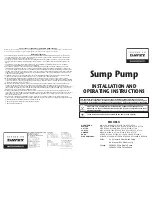
OPERATION
Operational guidelines
Securing the Template
There are various methods used to secure the template to the workpiece. The
experienced operator will choose the most appropriate according to the shape,
size and type construction of the template. For example, if the workpiece is large
enough to extend beyond the front of the table and still leave room for the
desired cut, it can be securely held to the template with "C" clamps as shown in
Fig.46.
In many situations the workpiece is positioned against the template using dowels
as anchor points and handles (wood blocks) to assist the operator in guiding the
workpiece through the cut as shown in Fig.47.
Special Cuts
The illustrations in this section show the profile, or section, views made by the
cutter. The most efficient cutters are carbide tipped to ensure clean and
long-term cutting. Small cutters may be solid carbide, and some use inserts.
Since there are such a wide variety of choices, the operator is limited only by his
experience and imagination.
Stacked Cutters
A variety of interesting and timesaving cuts can be made in a single set up by
stacking the cutters. When the operator stacks the cutters, extra care should be
taken to see that all parts are clean, free of nicks and flaws, and perfectly
balanced in the stacked position.
Sash and Door Shaping
Shaping a door requires two operations.
• Fig.48
shows the sash cut for the first operation.
• Fig.49
shows the stock flipped over and the sash cutter used with a 1/4”
groove cutter to complete the cut.
• Fig.50
shows the first shaping cut with the sash cutter for the matching door
stile sash.
• Fig.51
shows the same cut with the stock flipped over.
• Fig.52
shows the first shaping cut for a window sash stile utilizing a sash
cutter, collar, and a 1/2” groove cutter.
FIGURE 46
FIGURE 47
FIGURE 48
FIGURE 49
FIGURE 50
FIGURE 51
FIGURE 52



































